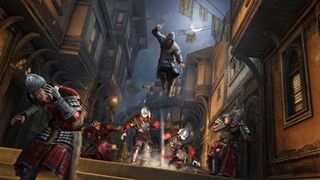SPONSORED: Assassin's Creed Revelations developer Q&A - locations
The Ubisoft development team on the latest Assassin's Creed
**Promotional Feature**
Members of the Assassin's Creed Revelations development team answer questions about their upcoming game.
You'll spend a lot of time in Revelations in Constantinople. That must have been quite a canvas to work with, can you tell us about the process of bringing it to life?
Raphael Lacoste: Our team invested itself heavily into both historical and on-location research to bring 16th century Constantinople to life. Via many trips to modern Istanbul to fully grasp the feel of the city, to hundreds of hours of research into the political and social realities of the period, we hope that we have brought this rich period of history to life in a convincing and believable manner.
Our approach was “hand crafted” and very artistic. The first step was to study maps from the 16th century to get the feeling of the different districts, main roads, public places and streets but also the overall shape of Constantinople. Historical maps were also very useful to locate the Landmarks and define the density of the city.

After this first stage of research, we created a map for the ground manually in our 3D software and we started to match the elevations based on the actual topography of Istanbul, only for the terrain. Then we did concept Art to define the mood of the different districts of the city (Beyazid, Imperial, Constantin and Galata), and used also historical paintings as reference for the modeling of the houses and Landmarks.
As we went to Istanbul in our research trip, we also felt the mood of the city and took a lot of pictures for textures and scale references. We re-created separately all the houses and landmarks we needed (with different variations for houses and generic landmarks) and started to fill the entire city around public places and streets.
Sign up to the 12DOVE Newsletter
Weekly digests, tales from the communities you love, and more
Our next challenge was to blend artistic direction and game-play navigation in the whole city, we managed to balance the image composition and navigation for the player in the setting. Tweaks were done for months to satisfy the artistic and gameplay experience, but also immersion in a memorable setting.
Constantinople was a place where Greek, Roman, Byzantine and Ottoman - where east has always encountered west - how did this influence your design work?
Raphael Lacoste: As Constantinople is the crossroads of the world and the center of the spice trade, we used this as an opportunity to create a very diversified setting. The city is cosmopolitan, filled with people from Europe, Asia and the middle east. This was a great opportunity to design a crowd with a lot of variations in the designs and colors.

The city is also littered with monuments built during the Byzantine Empire and Ottoman Empire, we exploited this to create a nice contrast and diversity in the look of our landmarks and main districts of the game. Our setting is now rich from its historical legacy.
Will we see iconic locations like the Blue Mosque, Hagia Sofia and the Topkapi palace in Revelations? What role with they play?
Alexandre Amancio: Assassin’s Creed Revelations includes all the famous landmark of Istanbul that were built at that time. Thus locations such as Hagia Sophia, Topkapi Palace Galata Tower and many more are present (Blue Mosque is not, as it was built in the 17th century and ACR happens in the 16th).
Many of these locations are home to secret locations, which in Revelations make a return and mark an evolution in the series as they are now epic sequences with high production values – think huge sequences of high adventure punctuating your overall experience.
We also return to Masyaf, the home of the Assassins during Altair's time - has it changed much in Revelations and what new areas of the assassins' home will we be able to explore?
Darby McDevitt: Because Revelations takes place 300 years after the events in AC1, Masyaf is in a fairly decrepit state. The castle, specifically, has been abandoned for quite some time, although in the months leading up to the events of Revelations, Templars have occupied its dusty, dank halls. But it is otherwise abandoned… a sad and lonely place.

There's also been whispers of a secret underground city in Cappadocia, what can you tell us about that?
Alexandre Amancio: Constantinople is not the only that players will visit. We have a new setting in the region of Turkey. It’s a mysterious city partly above ground but whose true secret is underground. This is the first time something like this has been done in the Assassin’s Creed franchise. It’s a huge and very rich environment where over ten thousand people have lived for hundreds of years. This massive city is based on actual cities that people can still visit today. Parts of the city are reminiscent of Petra with very busy merchant streets, and awe inspiring skylights to let the sun through.
Can you tell us how the assassins' dens will work?
Alexandre Amancio: The Assassins Dens are feature built from the ground up for Assassin’s Creed Revelations. In Constantinople, you can gain (and lose) control of the city’s districts. It is a reflection of the battle that is being fought in the streets between the Assassins and the Templars. It’s very organic, so a district that is controlled by the Assassins can be attacked by the Templars and then taken back, and vice-versa.
What was the biggest challenge and also the biggest pleasure in bringing Revelation's locations to life?
Raphael Lacoste: The first art direction challenge when creating a city in an Assassin’s Creed game is to nail the overall feeling for the game’s locations, and bring life to a historical city during a period that we weren’t able to witness first hand.
We start by asking our illustrators to create strong images that set the tone for the main color palettes, shapes and compositions that we want to see in the city. We then worked hard to create as much variety as possible in our districts, which will allow the player to become immersed in a host of rich and unique locations.

Our initial concept art then aimed to capture the sections of cities that will be featured on the game’s main path, and that will be memorable through both their unique atmosphere as well as their historical context. It is extremely important for us to create an impactful and harmonious visual signature, and we achieve this by placing a huge effort into the ambiance, lighting and shapes of our locations.
We feel that we’ve only done our job when the player feels completely transported away to a living, breathing world full of richness and detail, and we on the Assassin’s Creed Revelations art team are extremely proud of the work that we’ve done on bringing the game’s cities to life.
If you like Assassin's Creed, puzzles and free holidays, head over to Unlock the Animus for details on how these three things have been combined into one irresistible thing that you will be very interested in.
Oct 18, 2011
12DOVE was first founded in 1999, and since then has been dedicated to delivering video game-related news, reviews, previews, features, and more. Since late 2014, the website has been the online home of Total Film, SFX, Edge, and PLAY magazines, with comics site Newsarama joining the fold in 2020. Our aim as the global GamesRadar Staff team is to take you closer to the games, movies, TV shows, and comics that you love. We want to upgrade your downtime, and help you make the most of your time, money, and skills. We always aim to entertain, inform, and inspire through our mix of content - which includes news, reviews, features, tips, buying guides, and videos.

Assassin's Creed Shadows was originally envisioned without Yasuke, but Ubisoft wanted the full feudal fantasy: "We were sort of making a stealth tank, and it didn't quite work"

Assassin's Creed Shadows lead says dual protagonists are "a cool thing" the new action RPG "does better than what we've done in the past"










